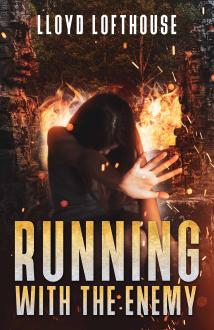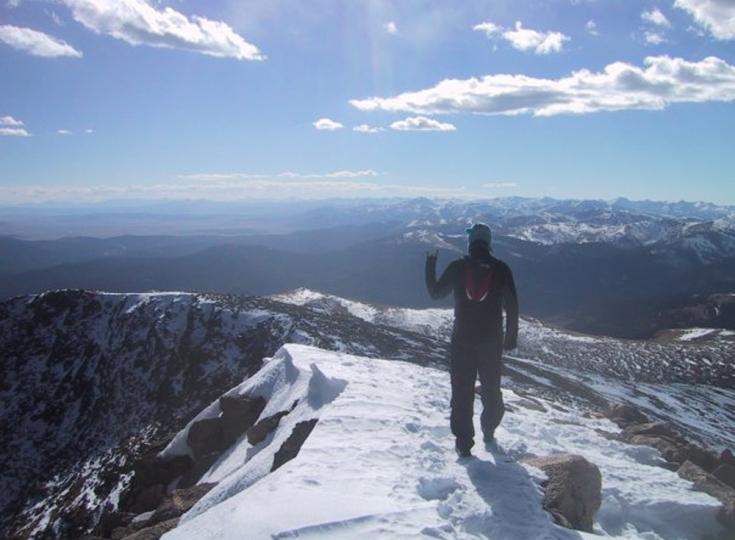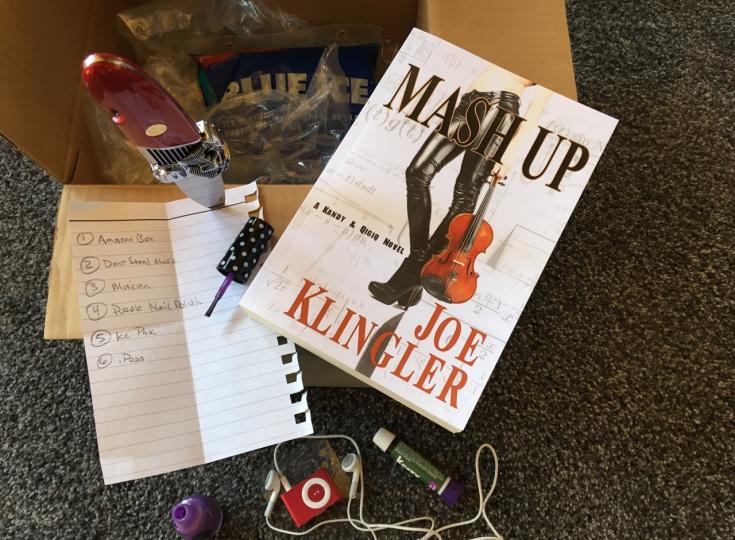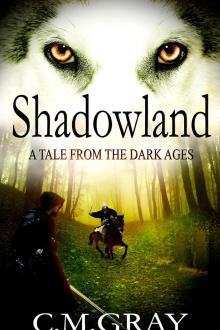Lloyd Lofthouse - Cat-and-Mouse Tension, Crackling Action, and a Touch of Forbidden Romance

Lloyd Lofthouse is a former U.S. Marine and Vietnam Veteran, who worked as a maître d’ in a 15 million dollar nightclub for a few years. He also taught English literature in the public schools for most of 30 years where he explored Romeo and Juliet with thousands of high school students.
A romantic at heart, in his award-winning novels, he tests true love in difficult situations and the challenges of keeping that love alive. My Splendid Concubine, his first novel, is an epic love story that teaches acceptance and respect for other people and their cultures. Running with the Enemy, his second novel, is a love story that will either cost the characters their lives or will complete each other’s hearts. As our Author of Our Day, he tells us all about Running with the Enemy.
Please give us a short introduction to what Running with the Enemy is about.
A relentless suspense thriller.
He joined to fight for his country. He went AWOL to save the woman he loves. And now he must put his loyalty on the line to survive. His crime… love across enemy lines. The oppressive peril of unceasing danger. The bloody lines of an all-out war. On the run across Southeast Asia, can they win a deadly game of cat and mouse?
What inspired you to write this story? Was there anything in particular that made you want to tackle this?
I think the answer to this question ended up in #3.
Your background as a Marine and Vietnam Veteran undoubtedly informs much of the content in “Running with the Enemy.” How did your personal experiences shape the narrative and characters in the book?
Running with the Enemy is a suspense thriller, and a love story (not a romance), but it started as a memoir, an independent project in 1982 that I pitched to my graduate advisor, while I was working toward an MFA at Cal Poly Pomona. I wanted to write the memoir to understand what happened to me over there. It wasn’t easy. Opening up that locked vault, let out some demons.
Long story shortened, a few years later, I found myself in a UCLA Extension writing workshop (where I stayed for seven years). During the first quarter, I shared the some of the Vietnam memoir I’d completed during that Cal Poly Pomona MFA program. The workshop’s professor thought I was limiting the story by telling it from my POV. She recommended turning the memoir into fiction. Still, I borrowed heavily from what happened to me and other Marines in my unit during 1966 while in Vietnam being shot at.
The fictional characters in Running with the Enemy do not represent any individuals in my Marine unit. Nevertheless, a lot of what happens to the characters in the novel happened to real Marines. What happens to the characters in the thriller are a composite of reality and my imagination.
“Running with the Enemy” features a blend of action, romance, and political intrigue set against the backdrop of the Vietnam War. What inspired you to tell this particular story?
The inspiration for Running with the Enemy came from Marines I served with in Vietnam and the complex history of China, French Indochina, Southeast Asia, and that almost 20-year long war (November 1, 1955—April 30, 1975).
Ethan Card, the protagonist of the novel, faces numerous challenges throughout the story, including betrayal, survival in a hostile environment, and the moral complexities of war. What aspects of Ethan’s character did you find most compelling to explore?
I wanted to explore Ethan’s loyalty to his lover, his Marine unit, and his country, the US.
While there in 1966, I knew about a Marine who went AWOL to stay with a local woman he fell in love with, instead of returning to the states when his tour ended. He wanted to marry her, but that was impossible since the military wouldn’t have approved. Others I knew tried in Okinawa and Vietnam and were all rejected.
With a week left before that Marine returned to the states, I remember seeing him sitting with her, and they were holding hands, looking miserable and crying buckets. The next morning, he was gone. They couldn’t stay in the local area near our base camp or her village, so they must have taken off. No one knows where they went. And if they were caught, we never found out. I wanted to explore what might have happened to them through Ethan’s story. Still, that real Marine was not Ethan, the POV character in the thriller. They didn’t even have the same Military Occupational Specialty (MOS). I also doubt the real couple was being chased by the monsters in the thriller hunting for Ethan and Tuyen.
Ethan is his unit’s armorer, and he’s framed for selling weapons to the Vietcong. The inspiration for the crime Ethan is accused of actually happened to my unit’s armorer near the end of my tour. That Marine sold weapons to the Vietcong and got caught. During the real Marine’s court-martial, he was found guilty. Ethan was innocent.
One of the other characters in the thriller that joins Ethan and Tuyen in their race across Southeast Asia was accused of raping a Vietnamese girl and killing her father. That character was based on another Marine in my unit, but the real Marine ended up spending a few decades in Leavenworth. He didn’t get a chance to escape.
“Running with the Enemy” has been described as a relentless suspense thriller. How did you maintain the pacing and tension throughout the narrative, especially during action sequences and moments of high stakes?
The relentless action and suspense in this thriller take place during their rush to escape across Southeast Asia from Vietnam to Thailand to reach Tuyen’s mother. The hunt starts after Ethan hijacks a US military helicopter, followed by him rescuing Tuyen, his French-Vietnamese lover. After the chopper crashes, they have to get out of Laos and cross Cambodia on foot.
The CIA, US Marines, and Viet Cong are all hunting for the lovers. In Laos Ethan and Tuyen have to avoid the Communist Pathet Lao guerrillas and in Cambodia, Pol Pot’s ruthless Khmer Rouge forces (have you heard of Pol Pot’s killing fields?). While on this desperate journey, everyone is a potential threat, until they reach their destination in Bangkok.
Still, with a ruthless rogue CIA agent and Tuyen’s Vietcong torture-happy psycho half-brother hunting for them, will they ever be safe?
Your background as an English literature teacher is evident in your exploration of character development and themes. How did your teaching experience influence your approach to crafting the story and engaging with readers?
I started learning to write years earlier while earning an AS degree (1968 -70) at a community college near my parents’ house, where I took my first creative writing class. From there, I earned a BA in journalism (1973) at Fresno State. Two years later, I returned to Cal Poly Pomona to add a teaching credential through a yearlong urban residency program.
After teaching for five years, I started an MFA program in the early 1980s, with a focus on writing while studying 20th century American authors. After the two years I spent working on the MFA, I switched to driving 130 miles round trip to UCLA once a week, to attend writing extension classes on that campus. The second term, some of us migrated across the street to our professor’s Westwood Village office over an Italian restaurant. I think she stole us from UCLA. Instead of paying UCLA, we paid her the same amount but got a lot more attention.
I started teaching in 1975. What I’d been learned about writing since 1968, I incorporated into my lesson plans. Teaching my students what I was learning was a powerful way to internalize those skills. I also know that we will never know everything. That learning never stops. If someone thinks they know it all, they don’t.
The novel received accolades and recognition, including being a runner-up in General Fiction at the 2013 Beach Book Festival. How did you feel about the reception of the book, and did any particular feedback surprise you?
I don’t remember any feedback surprising me.
When I want to know about the reception of my work after it’s published, I look at the numbers, comparing who liked the story to who didn’t. Today on Amazon, this novel has 100 ratings/reviews with a 4.3 average. On Goodreads, it has 45 ratings with a 4.1 average. If I’m surprised, it’s the fact that 79% of the readers on Amazon who rated or reviewed Running for the Enemy must have liked the story. Knowing that 8 out of 10 readers enjoyed what I wrote motivates me to keep writing… while still learning to improve my writing craft.
Of course, I also read the reviews. I want to know what readers think.
The Vietnam War is a complex and controversial period in history. How did you navigate the portrayal of this conflict, ensuring accuracy while also creating a compelling fictional narrative?
Running with the Enemy is not about the Vietnam War. It’s about a man and woman from different cultures who meet because of the war, and fall in love. That can happen in any war. This is Ethan and Tuyen’s survival story.
Still, I did a lot of research to understand what was going on across Southeast Asia and China. Most of what I learned didn’t make its way into the story. And reading about war seems to never end for many combat vets.
Most of the combat vets I know that live with the trauma of PTSD want to understand what happened to them. I’m not talking just about Vietnam. There are also combat vets in my PTSD support group who served and fought in the Middle East that they all call the Sandbox.
Kristin Hannah’s The Women, another war story set in Vietnam, was mentioned in one of our PTSD support group’s recent meetings. Now I’m reading it. I think everyone else in that support group is reading that novel too.
The book contains scenes of violence and brutality, reflecting the grim realities of war. How did you approach depicting these aspects of combat while maintaining sensitivity to the subject matter?
Since this thriller was written and shared with a critique group while I was in that UCLA Extension writing workshop over a period of years, I had a lot of feedback from our professor and the other writers in the group, who were mostly women. I remember revising one extremely violent chapter with a lot of action about 30 times to get it right. I was too cautious. The group encouraged me to be more graphic to show how horrible war is, but that took place in the 1980s. I don’t get that kind of feedback in critique groups today. Graphic violence and sex seem to offend more than it did decades ago. The critiques I get now go the other way. I hear I’m offended by the violence, the graphic sex. Soften it.
I have trouble with today’s reactions. How do we soften the horrors of war, of evil, to avoid offending someone?
When I finished Running with the Enemy, that UCLA professor found me an agent who took the manuscript to Random House, where a senior editor read it along with others. The friendly rejection letter said everyone that read the thriller at Random House liked the story, but … the Vietnam story market was glutted at the time and no one was buying those stores.
LOL!
That happened near the end of the 1980s. Running with the Enemy ended up on a shelf and had to wait until 2013 to get published, thanks to Amazon.
“Running with the Enemy” explores the concept of survival in extreme circumstances. What insights or messages do you hope readers take away from Ethan’s journey and the challenges he faces?
When the going gets tough, don’t panic. Stop and think. Losing control can get you and others killed. There’s a reason for the intense training Marines get. We are being programmed to react without thinking when unexpected disaster strikes. That training saved my life more than once.
Do you have any interesting writing habits? What is an average writing day like for you?
I’m a pantser. Well, at least until I’m about halfway into writing the rough draft for a novel length manuscript. Then I stop and start a POV plot and pacing chart to figure out where I’m at in the story and to learn what should happen next.
Stories sometimes start in the strangest ways. For example, the first action thriller in my Josh Kavanagh suspense series started in 2018, from a prompt in my VA PTSD support group. I didn’t intend to write a novel about that character. It happened several prompts later when I realized Josh refused to go away. He wanted his story to be a novel, not 15 minutes of writing to a prompt. That first prompt was about a combat vet coming home and that is the first chapter on his first thriller. The second prompt was to write something about heads or tails. That turned into the second chapter.
Josh’s first thriller, The Patriot Oath, was published in June 2021. Its sequel Never for Glory was released in June 2023. I’m working on the third military thriller in that series now, and I’m about halfway through the rough draft. Its title is Fiddling with Death. I think every character in that series lives with PTSD, even the antagonists, just like in Running with the Enemy. The evil characters get PTSD, too, but it seems to make them worse, not better.
Where can our readers discover more of your work or interact with you?
Readers may discover more of my work through my website or from my Amazon Author page. The easiest way to interact with me is on one of my three older blogs: iLookChina, Crazy is Normal, and The Soulful Veteran (a blog that focuses on the military, combat and living with PTSD).
https://www.lloydlofthouse.com/
https://www.amazon.com/stores/author/B002BM6VNU/allbooks
Also be sure to watch this video: https://www.youtube.com/watch?v=nYczyKKZzBQ
All the photos are original that I took with my camera in 1966 while in Vietnam, before the camera became a casualty while I was inside a tank on a field operation. I wanted to ride outside on top of the turret, but the tank commander said someone would shoot me before we’d reach our destination. I had to ride inside.
Better the camera than me. I liked that camera too.
Starting about 0.42 seconds in the video, there’s an image of a much younger me in the underground bunker we built (earlier images in the video show some of that construction – it was summer and it was HOT!). That’s me sitting at the bench in front of our battalion’s radios. I must have had someone else in my unit take that photo using my camera. There’s also a snapshot of the Playboy centerfold wall in our underground communication bunker.
The book cover in the video was one of the early versions I put together that has since been replaced.

If you like cat-and-mouse tension, crackling action, and a touch of forbidden romance, then you'll love this thriller. He joined to fight for his country. He went AWOL to save the woman he loves. And now he must put his loyalty on the line to survive. His crime… love across enemy lines. When psychopaths and blackmailers discover his secret, can this Marine survive the dirty fight for their lives?







